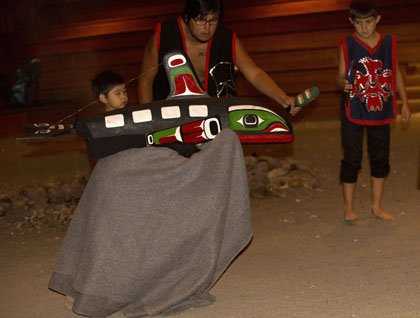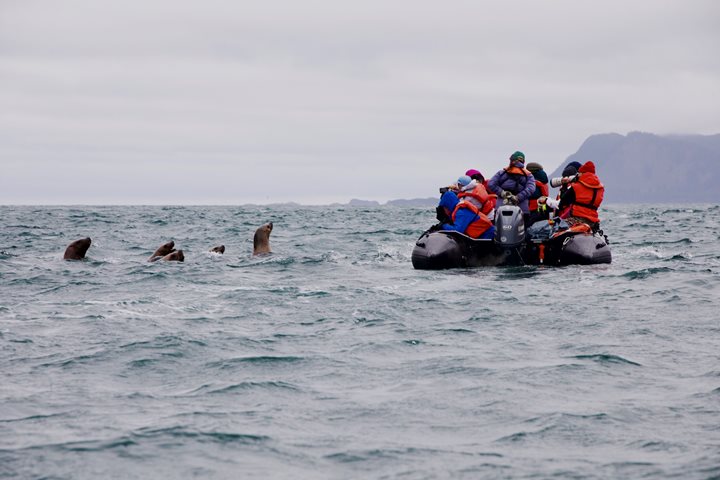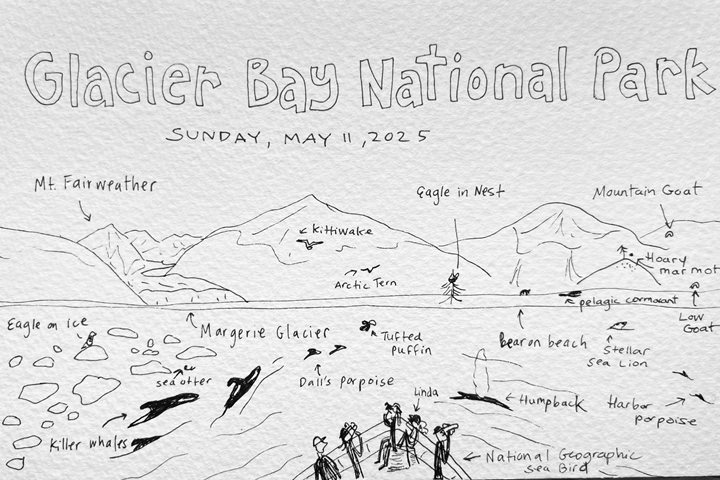At dawn this morning, the National Geographic Sea Lion was cruising slowing just north of Cormorant Island in Johnstone Strait. Our morning destination was Alert Bay and we were scheduled to tie up at the Government Dock at approximately 7:30 a.m.
Once breakfast was finished and the National Geographic Sea Lion was prepared for disembarkation, a small group of photographers took a short walk to the original Namgis burial grounds, where many totem poles of varying ages stood. The Kwakwaka’wakw began dedicating poles in these burial grounds in the early 1900s and have continued erecting memorial poles, including two new poles in 2015. It was a grey on grey day with shades of dark green, so the flamboyant colors the Kwakwaka’wakw are so famous for stood out wonderfully on the newer poles! Our small group of photographers spent their first hour ashore enjoying an opportunity to view the different style of NW Coast carving and begin getting acquainted with entering a community of another group of First Nations in British Columbia.
Alert Bay is particularly important along the NW Coast, as this was the first community to begin construction on an officially open Big House. The ban against potlatching had been in effect from 1884 until 1952 in Canada, leaving many First Nations communities without opportunities for expression of their birth right and culture. Mungo Martin was a high ranking Kwakaka’wakw Chief, a respected leader and renowned master carver responsible for training a whole generation of carvers. In 1953 Mungo Martin hosted the first official potlatch in Victoria, British Columbia. Then, returning home to Alert Bay, he was directly responsible for the building of the first Big House. That house was burned down by an arsonist in 1997 and immediately, the First Nations community rebuilt in the same location.
At 9:00 a.m. our walking group made the one mile walk through town to the U’mista Cultural Center. The center also provided a van for non-walkers. Once inside U’mista our group was divided into two groups and our host Lillian Hunt, a lifelong First Nations resident of Alert Bay was our guide to the lower gallery where she walked each group through a collection of repatriated potlatch regalia. The pieces are arranged in the same way as they would be displayed at a potlatch. As we admired the pieces, Lillian retold the stories attached to each piece. She also explained repatriation, as these pieces had been confiscated by the Canadian government in 1921 when a Cranmer Family potlatch was raided on Village Island. Government officials told the First Nations of Alert Bay, “if you want your regalia returned you must build a museum.” U’mista means a form of ransom in Kwakwala, which explains the elders of the community who affectionately refer to the U’mista as “The Box of Treasures.”
From the U’mista we were invited by the Tsasala Cultural Group to the gukwdzi or Big House. As is the custom amongst all First Nations, we were not just guests but also witnesses to an exhibition dance by a group of young Kwakaka’wakws. Children are considered our greatest resource and as we watched these children, some very young mixed in with slightly older and more experienced dancers, many of us realized we were witnessing the cultural future for this small community. An elder, Vera Cranmer introduced many of the dances we saw and slowly, through a visual feast, we were all taken into a world both seen and unseen. During the peace dances we witnessed a surprise, which was a killer whale dancer who danced across the floor and out a side door...mixed with weather dancers and salmon dancers! What could this mean for the rest of our day? Only time would tell. At the closing of our time in the Big House we, as guests and witnesses were gifted with freshly barbecued sockeye salmon and bacon covered in homemade jam. With great tastes in our mouths, and our hearts and minds full from the experience, we all enjoyed a leisurely walk back to National Geographic Sea Lion.
Radios had been noisily communicating sightings the entire walk back to the ship. In the distance we could see whale watching boats heading just north of Alert Bay. Locals stopped us on the street and told us, “killer whales heading north...you better hurry!” As soon as lines were dropped and National Geographic Sea Lion headed out into the main channel, our captain began maneuvering in and around a very playful group of young killer whales. Jumping, rolling, breaching, tail lobbing and just plain horsing around was happening along the shoreline of a small island. Then, these transient killer whales took an interest in our ship and decided to come closer and we could see the killer whale’s penis, known as a “pink floyd.” The entire bow was silent for a moment and then laughing and cheering.
It was a finale beyond belief for a two week trip of extraordinary sightings! Did those children and their killer whale dance call out to their relatives in the sea and gift us with wonderful sightings? In our hearts we knew....







